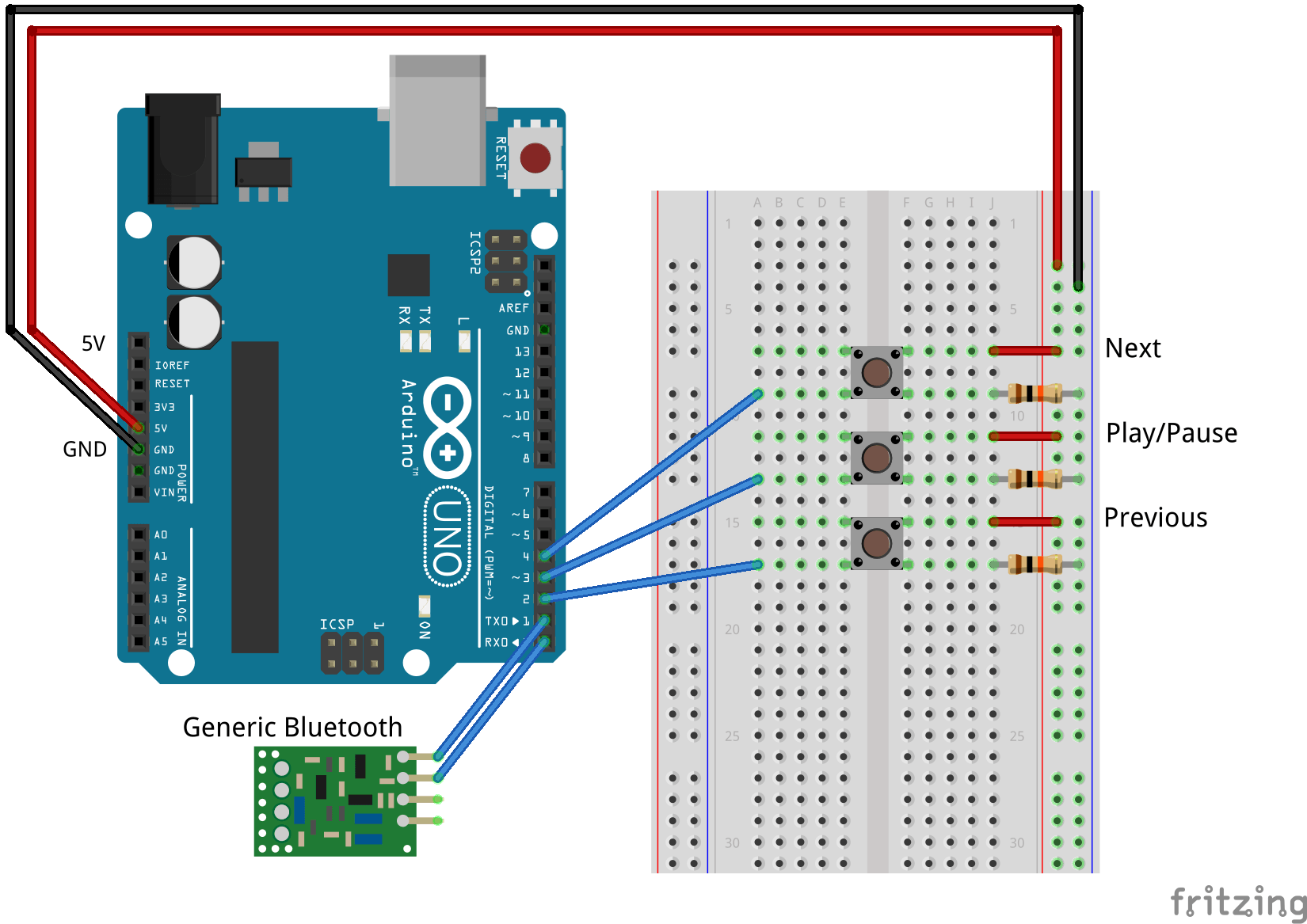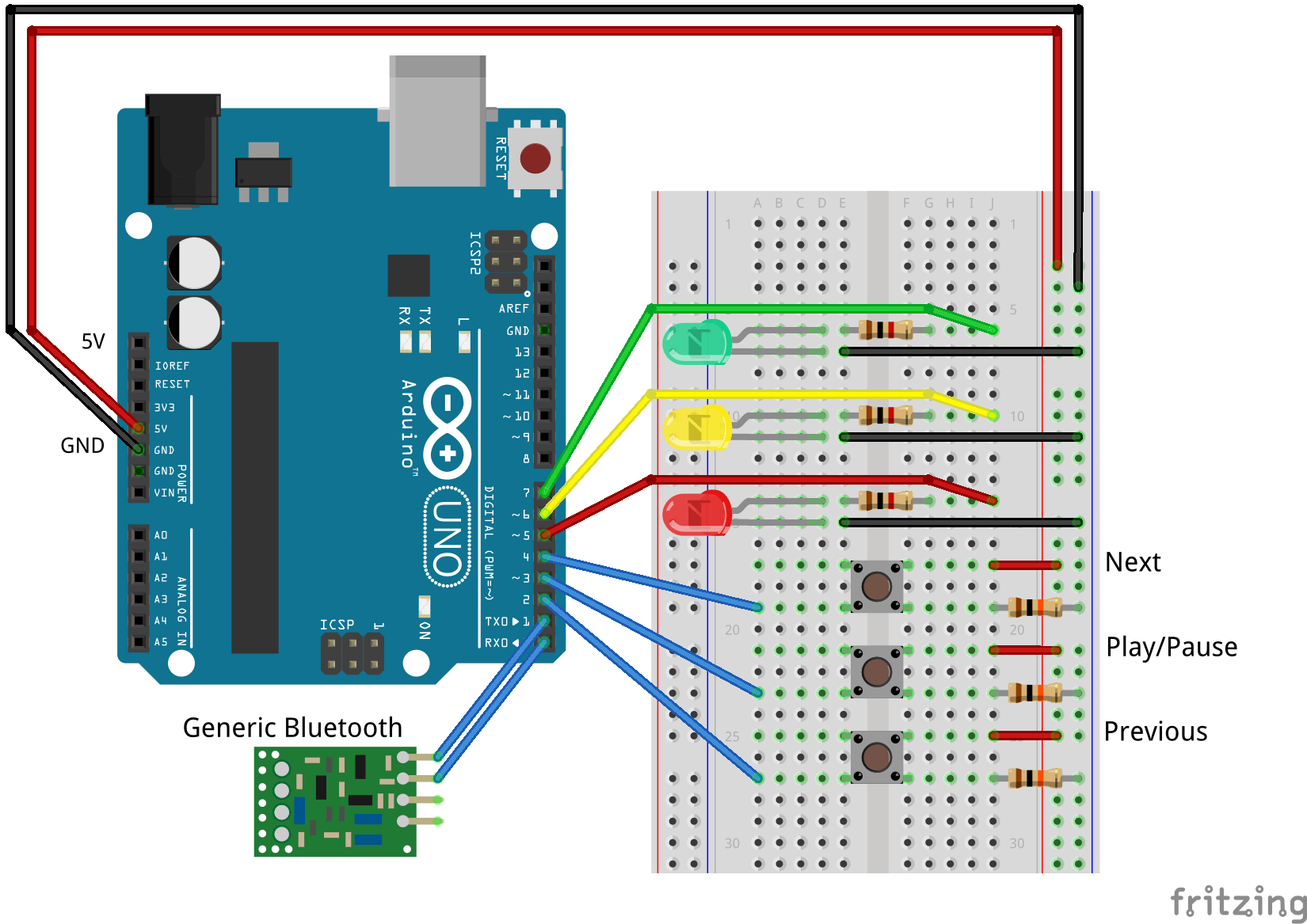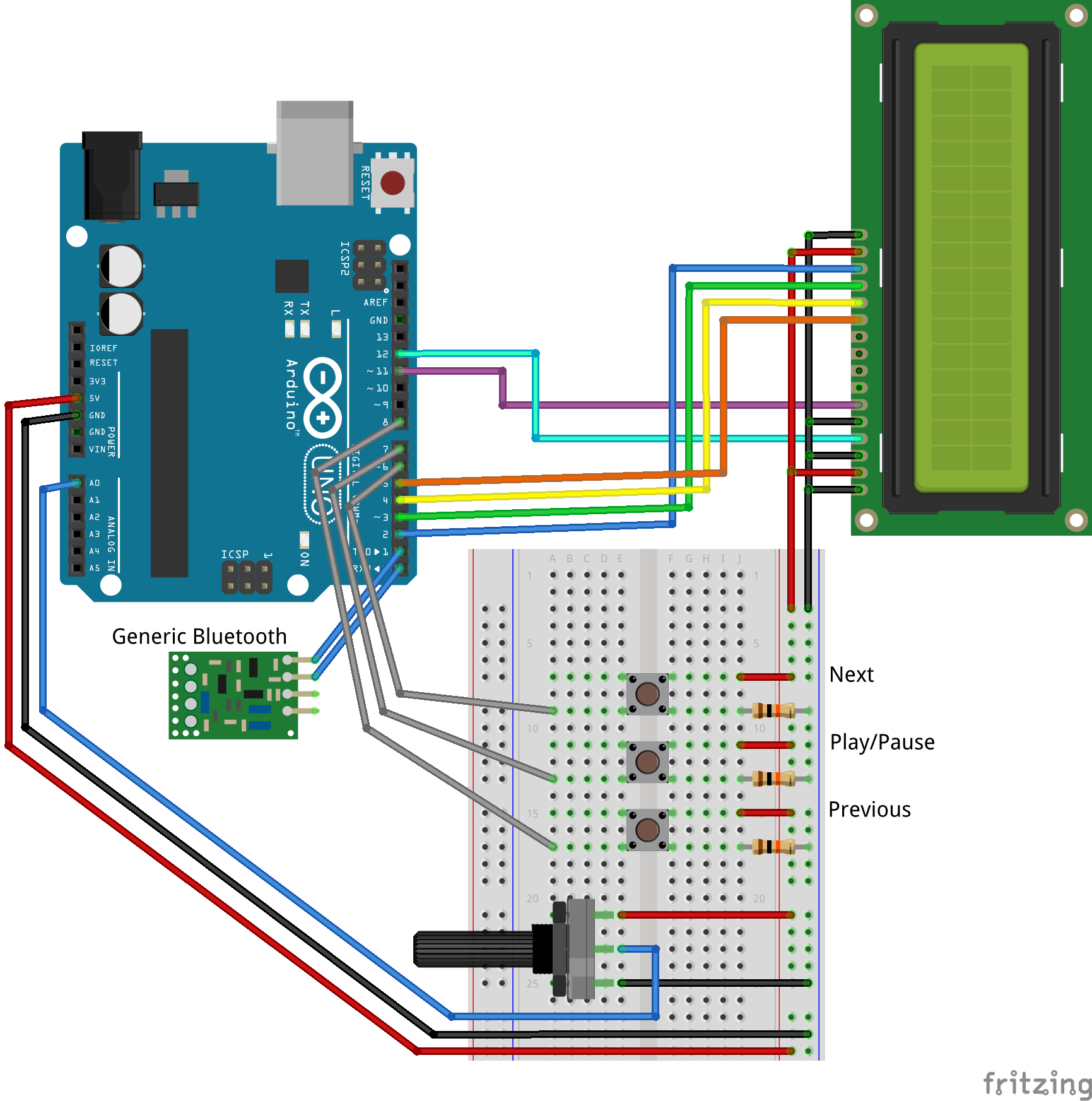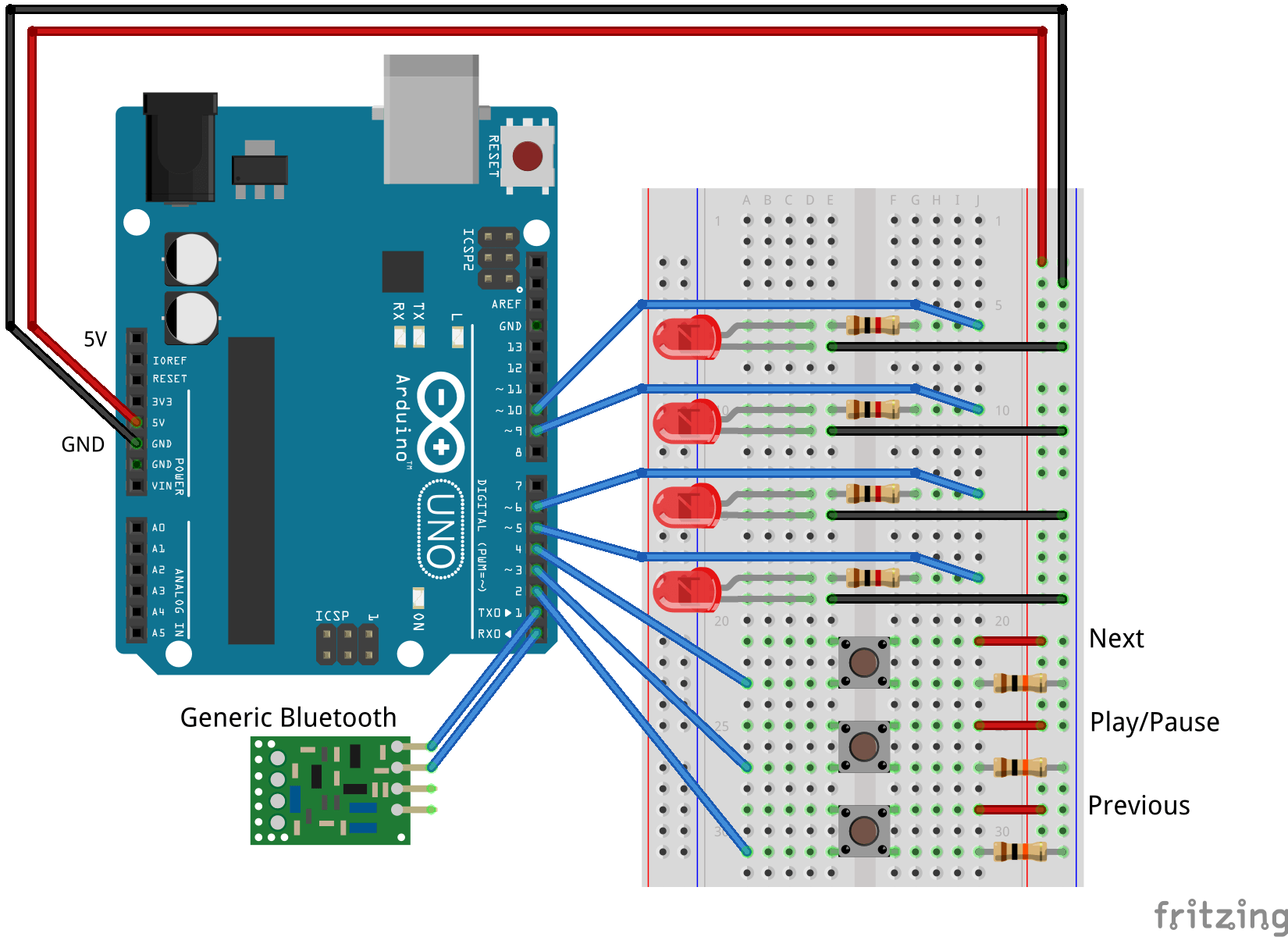Library to control the Android music player FPlay using an Arduino :)
You can download FPlayArduino library in a single zip file here!
FPlay communicates with Arduino using Bluetooth SPP - Serial Port Profile.
FPlay is available on GitHub at https://github.com/carlosrafaelgn/FPlayAndroid and on Google Play at https://play.google.com/store/apps/details?id=br.com.carlosrafaelgn.fplay
FPlayArduino consists of one object, FPlay, and several methods. The most common methods, control-related, are described below.
Return type: void.
Initializes all internal values and starts the serial port used by the library, using the given speed. For example: FPlay.begin(9600)
Note: If you own an Arduino Mega or other board with more than one serial port, you can choose which serial port the library will use by placing a macro before including the header. Here is an example of how to use Serial2 in Arduino Mega:
#define FPlaySerial Serial2
#include <FPlayArduino.h>
...Return type: void.
Processes all data received from the player (This MUST be placed somewhere inside loop(), and should be called as many times as possible to prevent data loss).
Example:
void loop() {
FPlay.process();
...
}Return type: bool.
Returns true or false to indicate whether the player is in the process of loading a song.
Note: this information is only available after hasNewStateArrived() has returned true at least once (see below).
Return type: bool.
Returns true or false to indicate whether the player is currently playing a song or is paused.
Note: this information is only available after hasNewStateArrived() has returned true at least once (see below).
Return type: int32_t (equivalent to Arduino's long).
Returns a value indicating the playback position of the current song in milliseconds, or -1 if the song is still loading or if the playback position is unknown.
Note: this information is only available after hasNewStateArrived() has returned true at least once (see below).
Return type: int32_t (equivalent to Arduino's long).
Returns a value indicating the length of the current song in milliseconds, or -1 if the song is still loading or if its length is unknown.
Note: this information is only available after hasNewStateArrived() has returned true at least once (see below).
Return type: uint8_t (equivalent to Arduino's byte).
Returns a value from 0 to 100 indicating the player's current volume level.
Note: this information is only available after hasNewStateArrived() has returned true at least once (see below).
Return type: void.
Changes the player's current volume level. volume is a byte/uint8_t value ranging from 0 to 100.
Return type: void.
Increases the volume level by one unit (this could be more than 1%).
Return type: void.
Decreases the volume level by one unit (this could be more than 1%).
Return type: void.
Starts playing the current song (nothing happens if the player was already playing).
Return type: void.
Pauses the playback (nothing happens if the player was already paused).
Return type: void.
Either starts or pauses the playback, depending on the current state of the player.
Return type: void.
Skips to the previous song in the current playlist.
Return type: void.
Skips to the next song in the current playlist.
Return type: void.
Requests the player to send fresh information with its internal state (whether it is playing/loading or not, current volume level, current song's position and length).
The player already sends this information automatically in key moments, like when one song ends and another starts, for example. However, if you want to keep track of current song's position, you should manually call this method (for this purpose, a recommended interval between successive calls is 250 ms).
Return type: bool.
Returns true the first time it is called after the player has sent its internal state, and returns false all other times. In other words, when hasNewStateArrived() returns true means isPlaying(), isLoading(), volume(), songPosition() and songLength() have had their values updated with fresh information.
You can always call the methods mentioned here before and they will always return valid values. The point is, these values are most of the time old (not perfectly synchronized with the player actual values). The values are only up-to-date when hasNewStateArrived() returns true.
FPlay is also able to send frequency-domain data in realtime, suitable for creating visualizers. This data consists of a series of bytes, each one indicating the amplitude of one or more frequencies (the frequency bins).
In order to receive such information you must first inform how many bins you would like to receive, using the FPlayBinCount macro. This MUST be placed before including the header:
#define FPlayBinCount 16
#include <FPlayArduino.h>
...Unlike the FPlaySerial macro, FPlayBinCount IS NOT optional and MUST always be specified. Valid values are either 0, meaning you do not wish to receive any frequency bins, or 4, 8, 16, 32, 64, 128 and 256.
You can control when the player starts and stops sending the bins either manually, by using the controls provided on the player's screen, or via code, by calling the methods FPlay.startFrequencyBinsTransmission() and FPlay.stopFrequencyBinsTransmission().
You can check when the bins are received by calling FPlay.haveNewFrequencyBinsArrived(). This method behaves just like hasNewStateArrived(), and will return true only for the first time it is called after the bins have been received (even though bin data is always available).
In order to improve performance, and reduce memory consumption, all bin data can be obtained accessing their array directly. For example:
...
analogWrite(5, FPlay.bins[0]);
analogWrite(6, FPlay.bins[1]);
analogWrite(9, FPlay.bins[2]);
analogWrite(10, FPlay.bins[3]);
...Each element in the array is one byte. Therefore, its value ranges from 0 to 255.
Each bin contains the amplitude of one or more frequencies. FPlay always works with 256 frequency bins internally and groups those frequencies as needed before sending them.
If you request 256 bins, these are the frequencies whose amplitudes are represented in each bin (0 Hz to 11025 Hz linearly distributed over 256 values):
FPlay.bin[0]: DC (0 Hz)FPlay.bin[1]: 43 HzFPlay.bin[2]: 86 HzFPlay.bin[3]: 129 Hz- ...
FPlay.bin[254]: 10982 HzFPlay.bin[255]: 11025 Hz
When you request less than 256 bins, the player will group more than one amplitude into one bin using different techniques, according to the situation. This grouping does not follow a linear scale, though. Instead, it uses an almost-logarithmic scale.
Note: For more information regarding this grouping/mapping, please, refer to the source code of the function commonProcess() in the file Common.h.
Return type: void.
Does the same initialization begin(speed) does, but calls begin(speed, config) on the serial port. Check out Arduino's reference for more information.
Return type: void.
Terminates the serial port used by the library by calling end() on the serial port.
Here you can find the layout for the examples that come with this library. The layouts were created using Fritzing and can be found here, in the Fritzing folder.
The source code for the examples is in the library (here) and are not being shown here to keep this file better organized ;)
In this example you will use three buttons to control the player's functions previous, playPause and next.
In this example you will use three buttons to control the player's functions previous, playPause and next. Also, there are three LEDs indicating the state of the player (whether it is playing or paused and if it is still loading a song).
In this example you will use three buttons to control the player's functions previous, playPause and next, and you will use a potentiometer to change the player's volume. Also, there is a LCD displaying both the position and length of the current song (in seconds).
In this example you will use three buttons to control the player's functions previous, playPause and next. Also, there are four LEDs "pulsing" along with the amplitude of four frequency bins.
This projected is licensed under the terms of the FreeBSD License. See LICENSE.txt for more details.



